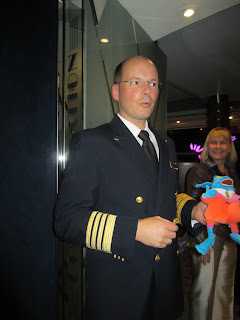There are a few theories amongst the two hundred million
Brazilians as to the best place in Brazil.
None would argue, however, that Sao Paulo is the driver of the thriving
business of Brazil. Locals like to compare the city to New York – um, no… but with
a population of 21 million it’s certainly the largest city we've been in.
 |
| Cityscape Sao Paulo |
It’s also the fastest growing city in the
world and has 8 million cars – I swear we encountered most of them, yet there elegant parks and buildings.
 |
| Elegant gardens |
Despite that, it’s also (like all of Brazil) very ethnically
diverse, with (for example) the largest Japanese population outside Japan. Unlike the more western countries of South
America, there were few native inhabitants in Brazil when the Portuguese first
arrived and consequently immigrants were encouraged to take up land grants and
intermarry. This included the estimated 4 million of slaves from West Africa. This has led
to a country that doesn't discriminate by skin colour – nearly everyone is a
mix – but does on wealth. who were not formally freed until 1888.
The Portuguese originally founded Brazil in 1500 as a colony. During the Napoleonic
invasion of the Iberian Peninsula in the early 1800s, the Portuguese king (and
150,000 of his closest allies) actually moved the Kingdom to Brazil from 1808 to 1821 until after
the conflict was resolved.
So when the King returned to Portugal, he left his son Pedro
I behind as Emperor from 1822 and Brazil remained part of the Portuguese Empire until the
1889, when the then emperor Pedro II conceded that independence was inevitable and
handed over the reins to the military. This is a very simplified version of events.
Brazil is the fifth largest country in the world (Australia’s
the sixth) and is larger than the mainland USA.
Most of the population is concentrated in the south-east of the country
with the north dominated by the Amazon basin.
It’s the largest Portuguese speaking country in the world and has an
African population (by descent) second only to Nigeria!
Like Argentina, Brazil has a female President Dilma Rousseff
(she’s of Bulgarian descent). She seems
well respected by all whether they vote for her or not. The huge Petrobras corporation also has a
female president who actually is a favela gal who came through the ranks the
hard way.
The wealth disparity is shifting a bit – the middle class
now represents over 46% of the population, the wealthy 15% and the poor
39%. This disparity has led to the
country’s relatively low record in literacy (functional illiteracy 21%) and
education – the public schools often do not have good outcomes; their teachers
are reportedly not well paid and those that can, teach in the better paid private
schools. This is more pronounced in the
Northern regions of the country.
The best universities are, however state run and free – but are
of course hard to get into, so if you have a public school education you are
unlikely to be able to go. Getting the
picture? A bit of a dichotomy they are
trying to address by having a 20% quota for disadvantaged public school
graduates in the public universities.
Back to Sao Paulo…
The port for the city is the forgettable (other than the football team)
Santos, but the trip up to Sao Paulo’s elevation was stunning if not a little
scary
 |
| Santos to Sao Paulo |
– but dotted with the delightfully prolific Manaca trees.
 |
| Roadside Manaca trees |
The city is noted for its cuisine and we
certainly had a great chuarassco lunch - that's meat on mega skewers.
There are elegant parks including one in the middle of the busy
financial district that’s still original forest complete with spider monkeys. The architecture is mixed and the graffiti original
 |
| Check out the graffiti, colonial Sao Paulo |
Like other Brazilian cities we've encountered, architecture
is a mix of Portuguese Colonial, early 20th century and modern. They’re never going to win the ‘Tidy Town’
competition, however they throb with life – and isn't that more important?















































.JPG)


